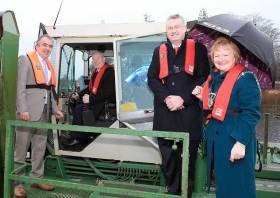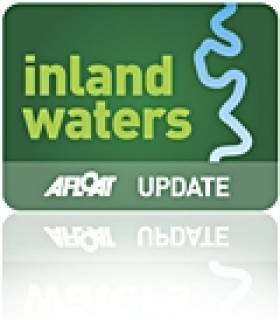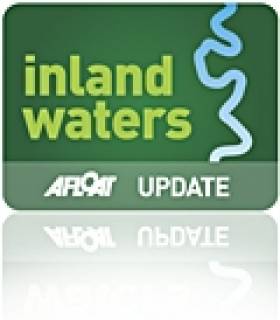Displaying items by tag: Shannon Blueway
The third phase of the Shannon Blueway has been opened by Michael Ring, Minister for Rural and Community Development, in the company of Waterways Ireland’s acting chief executive John McDonagh and Leitrim County Council Cathaoirleach Enda McGloin.
The project has created a new path along the shores of Lough Allen linking four tourism businesses to the lock at Blackrock and Drumshanbo town and increasing access for walkers, cyclists and horseriders.
This involved the upgrade of 1km of an existing pathway along the Lough Allen canal between Acres Cove Marina and Drumshanbo Lock at Blackrock, and the installation of a new controlled pedestrian crossing on the R208, the only road crossing on this section.
Car parking for 13 vehicles has also been created, with a new entrance to Drumshanbo Lock at Blackrock and the newly developed Blueway.
The new section of Blueway path runs north from this point along the shores of Lough Allen, and includes a pedestrian bridge across the Millrace River connecting the town with a range of existing amenities.
Funding for the project was obtained by a partnership of Waterways Ireland and Leitrim County Council under the Outdoor Recreational Infrastructure Scheme through the Department of Rural and Community Development.
A total of €340,000 of Outdoor Recreational Infrastructure funding has been match-funded with €86,000 by Waterways Ireland.
Minister Ring said: “I am delighted to launch Phase 3 of the Shannon Blueway here in Leitrim. This will build on the success of Phases 1 and 2 of this project which were supported by my Department and which have brought 100,000 new visitors to this rural area, creating opportunities for business growth, new businesses and jobs.
“Phase 3 links a further four existing business to the Blueway and will be instrumental in increasing the time and money people spend in this area. This has been a wonderful collaborative effort between my Department, Waterways Ireland and Leitrim County Council.”
John McDonagh added: “Blueways are an excellent way of linking the waterways and paths we manage with tourism businesses and recreation clubs providing opportunities for people to experience the outdoors, nature and adventure.”
Waterways Ireland says the Shannon Blueway has proved to be a catalyst for ongoing rural development, social inclusion and job creation, and had so far led to the establishment of eight water-based recreational businesses.
In 2018 alone, 100,000 visitors used the Blueway facilities at Acres Lake, which are utilised for numerous sporting and charitable events, as a community resource and public asset.
The opening in Leitrim comes in the same week as the launch of a new development guide and accreditation scheme for Blueway development on the island of Ireland.
This initiative sees a number of State agencies working in partnership on an all-island basis to see the development of Blueway sites in the Republic of Ireland and Northern Ireland over the coming years.
Floating Boardwalk Completes Shannon Blueway At Acres Lake
#InlandWaters - The floating boardwalk at Acres Lake in Co Leitrim — a first for Ireland — is now open, completing the final leg of the Shannon Blueway.
Afloat.ie previously reported on the project in Drumshanbo when current Rural Development Minister Michael Ring visited the site to meet with Waterways Ireland staff last December, in his previous capacity as Minister of State for Regional Economic Development.
The 600m Blueway Boardwalk between Drumshanbo and Carrick-on-Shannon completes a 14km section of the blueway and connects it to a near 200km network of paths for walkers and cyclists across the waterways of Leitrim, Roscommon, Longford and Cavan.
Minister Ring described the €500,000 project as “an excellent investment” when he attended its opening yesterday (Tuesday 5 September).
A further €1.1 million has been allocated for a new walking and cycleway from Carrick-on-Shannon to Leitrim village and between Acres Lake and the Lough Allen Hotel, according to The Irish Times.
Minister Ring T.D. has awarded €500,000 to Waterways Ireland for the completion of the Shannon Blueway between Leitrim Village and Drumshanbo town. The project will include an iconic boardwalk around the southern side of Acres Lake. The attractive new walkway will be constructed partly on land and a significant section will be designed to float over the water. This work will complete a 14–km section of the Blueway, bringing it into the Blueway network which is now nearing 200km in length running across Leitrim, Roscommon, Longford and Cavan.
The Shannon Blueway is a new recreation and tourism concept that has been developed by Waterways Ireland and a number of key partners including Leitrim, Roscommon and Longford County Councils, the National Trails Office and Canoeing Ireland.
The Blueway is a series of quality multi-leisure activity trails both on and off water that offers a wider and deeper experience through associated activities and attractions. There are now 8 activity providers operating on the Blueway and accommodation & hospitality sector in the wider geographical area developing interesting and exciting packages for families and friends to experience. (www.bluewaysireland.org)
The first section of Blueway (funded by the Rural Recreation Grant Aid) opened in October 2014 and has achieved huge success and recognition to date. It comprises 3 looped walks and 16km of canoe trails connecting Carrick-on Shannon to Drumshanbo. It has already received two awards and has attracted over 100,000 visitors since opening.
The grant approved by Minister Ring T.D., will provide a critical connection in the walking and cycling element of the Blueway. The iconic boardwalk provides linkage for the existing 14km of looped walks to the facilities and services at Acres Lake and Drumshanbo town another key element of Blueway infrastructure.
Waterways Ireland and Leitrim County Council, manage and operate a fully serviced community and boating resource at Acres lake which includes a marina, car-parking, toilets and showers, outdoor swimming pool, tennis courts, angling facilities and the Sliabh an Iairann Visitor Centre. By connecting these facilities to the existing looped walk and cycle path the area can be utilised as a trail head and will anchor and integrate the Blueway in the town of Drumshanbo and the wider Roscommon and Leitrim hinterland
The project will involve the construction of a path from the current terminus near Drumhauver Bridge to the edge of Acres Lake; the procurement and installation of the floating walkway, and the construction of a new path linking the walkway to the services at Acres Lake. It is anticipated geotechnical works and preliminary site works will commence by the end of November 2016. Waterways Ireland is in the process of procuring the floating walkway. The scheme is expected to be completed by May 2017 in time for the main boating and tourist season.
Quayside Works At Lanesborough-Ballyleague For Shannon Blueway
#InlandWaters - Quayside enhancements at Lanesborough-Ballyleague are part of a new project to develop facilities along the award-winning Shannon Blueway.
The Flagship REDZ project was submitted by Leitrim County Council on behalf of the Upper Shannon Erne Future Economy (USEFE) project partners, which include Bord Na Mona, ESB and Cavan, Leitrim, Longford and Roscommon Local Authorities in conjunction with Waterways Ireland.
The aim of this project is to develop the Shannon Blueway to support the wider economic development of the towns and villages along the Shannon and Erne Waterways.
The blueway is a developing a multi-activity trail running alongside the water which links walking, cycling, canoeing, paddle boarding, angling and cruising with local amenities.
Twenty-two towns and villages in the Upper Shannon-Erne region are inter-connected by the Shannon and linked canals, providing what Waterways Ireland describes as "a unique opportunity to develop the blueway concept".
As part of the objectives of the REDZ Flagship project for the Shannon Blueway, the quayside improvements at Lanesborough-Ballyleague will be joined by an extension of the looped walks from Drumleague to Drumhauver, a multi-leisure section of the blueway from Carrick-on-Shannon to Drumshanbo.
Click HERE to view a Facebook gallery dedicated to the quayside improvements in Lanesborough-Ballyleague.
#InlandWaters - The Shannon Blueway initiative received its second major award of the year at a star-studded event in Limerick's Thomond Park recently.
The European Sports Tourism Innovation Award was presented by Ireland's 6 Nations winning captain Paul O'Connell and Keith Wood of W2 Consulting to the Shannon Blueway partners Leitrim Tourism and Waterways Ireland at the prestigious European Sports Tourism Summit Awards on 14 May last.
Launched in October 2014, the Shannon Blueway is the first of its kind in Ireland where a myriad of recreational activities have been developed and bundled together as a single or multiple visitor experience and tourism proposition.
Waterways Ireland has developed and built a canoe trail from Drumshanbo through Battlebridge and Leitrim village to Carrick-on-Shannon. It has also developed a series of looped walks adjacent to the Lough Allen Canal, with plans to expand those walks to Drumshanbo and Carrick on Shannon.
At the same time, Waterways Ireland is also developing a canoe trail from Leitrim village along the 63km of the Shannon Erne Waterway with a walking and cycling trail also at an advanced stage of planning.
The wider Shannon Blueway, of which the Drumshanbo to Carrick-on-Shannon section is part, is at the heart of access to 100km of paddling area, six looped walks (three of which are on the canal towpath), two long-distance walks and three heritage trails. The blueway will ultimately provide access to 14 towns and services with each access point and town within an hours' paddling time.
The Shannon Blueway is being delivered by Waterways Ireland in partnership of the Irish Sports Council, Canoeing Ireland, Leitrim County Council, Leitrim Tourism and Fáilte Ireland.
Chief executive Dawn Livingstone confirmed that partnership was the key to delivering the Shannon Blueway.
"Waterways Ireland has invested significantly in creating world beating facilities and services on the Shannon Navigation and is delighted to see this initiative recognised with the European Sports Tourism Innovation award.
"Through our partnership with the National Trails Office, Canoeing Ireland, Leitrim Tourism and Leitrim County Council an outstanding multi-activity product has been built in the Shannon Blueway which is now being packaged by clubs and communities for their recreational activities and companies and organisations for domestic and international tourists. Partnership is key to delivering the future of the Shannon Blueway further into Leitrim and into Roscommon, Longford and Cavan."
Frank Curran, CEO of Leitrim County Council, said that the Shannon Blueway "represents an excellent product that has been developed through collaboration between Waterways Ireland and Leitrim County Council to facilitate the development of this signature tourism offering for Co Leitrim and the region."
The European Sports Tourism Innovation Award is the second prize this year for the inland waterways initiative, after taking the Best Tourism Initiative category of the 2015 Community and Council Awards in January.
Shannon Blueway Named Ireland's Best Tourism Initiative
#InlandWaters - The Shannon Blueway has won the Best Tourism Initiative category of the 2015 Community and Council Awards presented by LAMA in association with IPB.
Waterways Ireland – which have led the development of the Shannon Blueway – attended the ceremony represented by Norma Herron, with Leitrim County Council cathoirleach Paddy O'Rourke and chief executive Frank Curran.
The Shannon Blueway is a multi-activity trail running alongside water, linking walking, cycling, canoeing, paddle-boarding, angling and cruising with local towns and villages.
Launched in October 2014, thousands of walkers, paddlers and cyclists have already enjoyed this first section of the trail from Drumshanbo to Carrick-on-Shannon, including 16.5km of canoe trail and 10km of approved walking route.
And the route is already growing, with new sections to be opened later this year on the Camlin River.
The Shannon Blueway is being delivered in partnership with the National Trails Office, Canoeing Union, Leitrim County Council and Leitrim Tourism and is being marketed under the Blueways Ireland banner on the web, Facebook and Twitter.
































































